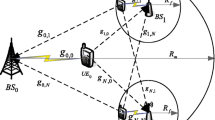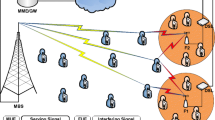Abstract
In this paper, a robust power control algorithm is proposed in two-tier femtocell network system in order to address the uncertain channel gains of the interference links. In the algorithm, an outage probability is used to guarantee the communication qualities of users. As the deterministic form of the outage probability constraint is not convex of power, a novel and simple method is utilized to solve the power allocation problem. The allocation solution can be determined based on the average channel gains which are engaged with a dynamic factor with average signal-to-interference-plus-noise ratio. In the scheme, a dynamic power adjustment algorithm is developed. The algorithm attempts to guarantee the outage probability requirement of the macrocell user, and to achieve the optimal power allocation of femtocell users. Apart from the appropriate resource for the network, an admission control algorithm is adopted to remove the femtocell user whose communication quality can not be ensured. Numerical results demonstrate the effectiveness of the robust power control algorithm and also explain the admission control algorithm.





Similar content being viewed by others
References
Liu Z, Hao L, Xia Y, et al. (2015) Price bargaining based on the Stackelberg game in two-tier orthogonal frequency division multiple access femtocell networks. IET Commun 9(1):133–145
Treeumnuk D, Popescu D (2014) Enhanced spectrum utilisation in dynamic cognitive radios with adaptive sensing. IET Signal Proc 8(4):339–346
Zheng K, Wang Y, Lin C, et al. (2011) Graph-based interference coordination scheme in orthogonal frequency-division multiplexing access femtocell networks. IET Commun 5(17):2533– 2541
Duan L, Huang J, Shou B (2013) Economics of femtocell service provision. IEEE Trans Mob Comput 12(11):2261– 2273
Calin D, Claussen H, Uzunaliglu H (2010) On femto deployment architectures and macrocell offloading benefits in joint macro-femto deployments. IEEE Commun Mag 48(1):26–32
He S, Chen J, Li X, et al. (2014) Mobility and intruder prior information improving the barrier coverage of sparse sensor networks. IEEE Trans Mob Comput 13(6):1268–1282
Chandhar P, Das S (2014) Area spectral efficiency of co-channel deployed OFDMA femtocell networks. IEEE Trans Wirel Commun 13(7):3524–3528
Guan X, Han Q, Ma K, et al. (2013) Robust uplink power control for co-channel two-tier femtocell networks. AEU Int J Electron Commun 67(6):504–512
Duy N, Long L, Hossain E, et al. (2012) Distributed interference management in two-tier CDMA femtocell networks. IEEE Trans Wirel Commun 11(3):979–989
He S, Shin D, Zhang J et al (2015) Full-view area coverage in camera sensor networks: dimension reduction and near-optimal solutions. IEEE Trans Veh Technol. doi:10.1109/TVT.2015.2498281
Chandrasekhar V, Andrews J, Gatherer A (2008) Femtocell networks: a survey. IEEE Commun Mag 46(9):59–67
He S, Chen J, Yau K et al (2010) Energy-efficient capture of stochastic events under periodic network coverage and coordinated sleep. IEEE Trans Parallel Distrib Syst 23(6):1090–1102
Han Q, Bo Y, Wang X, et al. (2014) Hierarchical-game-based uplink power control in femtocell networks. IEEE Trans Veh Technol 63(6):2819–2835
Wang H, Ding Z (2015) Power control and resource allocation for outage balancing in femtocell networks. IEEE Trans Wirel Commun 14(4):2043–2057
Wang H, Ding Z (2014) Macrocell-queue-stabilization based power control of femtocell networks. IEEE Trans Wirel Commun 13(9):5233–5236
Kim M, Hui J, Tobagi F (2010) Cross-tier interference mitigation for two-tier OFDMA femtocell networks with limited macrocell information. In: Proceeding of the international conference on global telecommunications conference, Miami, pp 1–5
Zappone A, Chong Z, Jorswieck E, et al. (2013) Energy-aware competitive power control in relay-assisted interference wireless networks. IEEE Trans Wirel Commun 12(4):1860–1871
Sengupta S, Chatterjee M, Kwiat A (2010) A game theoretic framework for power control in wireless sensor networks. IEEE Trans Comput 59(2):231–242
Hyungsik J, Zhang R (2014) Throughput maximization in wireless powered communication networks. IEEE Trans Wirel Commun 13(1):418–428
Jindal N, Weber S, Andrews J (2008) Fractional power control for decentralized wireless networks. IEEE Trans Wirel Commun 7(12):5482–5492
Youngmin J, Quek T, Hyundong S (2011) Beamforming optimization for multiuser two-tier networks. Commun Netw 13(4):327–338
Liu Z, Wang J, Xia Y, et al. (2013) Robust optimisation of power control for femtocell networks. IET Signal Proc 7(5):360– 367
Dong K, Long L, Hossain E (2008) Joint rate and power allocation for cognitive radios in dynamic spectrum access environment. IEEE Trans Wirel Commun 7(12):5517–5527
Yates R (1995) A framework for uplink power control in cellular radio systems. IEEE J Sel Areas Commun 13(7):1341– 1347
Acknowledgment
This work is supported in part by the National Science Foundation of China (Project numbers 61473247, 61573301, 61573303).
Author information
Authors and Affiliations
Corresponding author
Appendices
Appendix
The detailed proofs of the proposition in Section 3 are given as follows
Appendix A
Proof
First introduces the Cauchy-Schwarz inequality
we can elaborate the follow
then we can obtain
formulation (11) can be rewritten as follows
When G i, j is assumed to be an exponential distribution with unit mean, we can obtain
We assume that Y = |x| = |G i, j |. Based on Eq. 32, the distribution function of Y can be elaborated as
The probability density function of Y is \(f_{Y}(y)=F_{Y}^{\prime }(y)\), hence,
Based on Eq. 34, we are aware that |G i, j | is also an exponential distribution with parameter 1. Next, we introduce the Gamma (Γ) distribution. If X conforms a gamma distribution with the parameters α and β (i.e. X ∼ Γ(α, β)), the probability density function of X can be formulated as :
Assume that X and Y are independent to each other (i.e. X ∼ Γ(α 1, β), Y ∼ Γ(α 2, β) and Z = X + Y), the probability density function of Z can be formulated as,
If and only if x > 0 and z − x > 0, the integrand is not zero. If z ≤ 0,f Z (z) = 0. If z > 0, f Z (z) is given as:
the β(α 1, α 2) is the function of β. Based on Appendix C, the relationship between Γ function and β function can be formulated as
Hence,
and Z ∼ Γ(α 1 + α 2, β). If X, Y and Z are independent to each other, X ∼ Γ(α 1, β), Y ∼ Γ(α 2, β), Z ∼ Γ(α 3, β) and U = X + Y + Z. Based on the same token, we can obtain U ∼ Γ(α 1 + α 2 + α 3, β). This conclusion can elaborate to multiple independent Γ distribution. If X i ∼ Γ(α i , β), then
From the formulation (34), we know that |G i, j |∼Γ(1,1). Based on Eq. 40, we can be obtained,
Hence, the probability density function of \({\sum }_{j=0,j\neq i}^{N}|G_{i,j}|\) can be elaborated as
Based on Eqs. 31 and 42, the value of \(\mathcal {P}_{f_{i}}\) can be expressed as
Based on the properties of the gamma function, Γ(N) = (N−1)!, the value of \(\mathcal {P}_{f_{i}}\) can be obtained as follows
where \(A_{i}=\frac {1}{\sqrt {{{\sum }_{j=0,j\neq i}^{N}{p_{j}^{2}}\overline {g}_{i,j}^{2}}}}\left (\frac {p_{i}g_{i, i}}{\widehat {\gamma }_{i}}-\sigma ^{2}\right )\) and \(t={\sum }_{j=0,j\neq i}^{N}|G_{i,j}|\). The value of \(\mathcal {P}_{f_{i}}\) is obtained. □
Appendix B
Proof
Based on the Cauchy-Schwarz inequality, we can obtain:
and (17) can be rewritten
where \(g_{i}=G_{i}{\bar {g_{i}}}\) and G i is the exponential distribution with the parameter of 1. Similarly, we can obtain
The probability density function of \({\sum }_{i=1}^{N}|G_{i}|\) is
By elaborating (46) and (48), the probability of \(\mathcal {P}_{m}\) can be obtained as
where we define \(B=\frac {1}{\sqrt {{{\sum }_{i=1}^{N}{p_{i}^{2}}\overline {g}_{i}^{2}}}}\left (\frac {p_{0} g_{m}}{\widehat {\gamma }_{m}}-\sigma ^{2}\right )\), \(u={\sum }_{i=1}^{N}|G_{i}|\). The value of \(\mathcal {P}_{m}\) is obtained. □
Appendix C
Proof
First, the gamma function is defined, \({\Gamma }(\alpha )={\int }_{0}^{+\infty }x^{\alpha -1}e^{-x}dx\). Then, the beta function is defined as \(\beta (p,q)={{\int }_{0}^{1}}x^{p-1}(1-x)^{q-1}dx\). Then we prove the relationship between gamma function and beta function. Given that
Hence, we can obtain
and
Based on Eq. 52, we can obtain the following
As β(p, q) = β(q, p), we can elaborate the following
Hence,
Since β(1, 1) = 1, we can obtain
So we obtain
□
Rights and permissions
About this article
Cite this article
Liu, Z., Li, S., Guan, X. et al. A robust power control scheme for femtocell networks with probability constraint of channel gains. Peer-to-Peer Netw. Appl. 11, 21–33 (2018). https://doi.org/10.1007/s12083-016-0486-8
Received:
Accepted:
Published:
Issue Date:
DOI: https://doi.org/10.1007/s12083-016-0486-8




